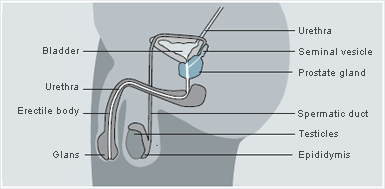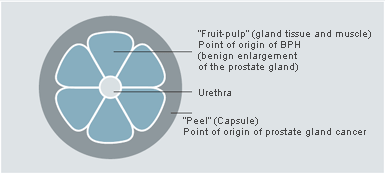The prostate gland produces a secretion that forms the basis of seminal fluid. Its main function is to protect the sperm from the acetous environment in the vagina. The prostate is shaped like a chestnut and in young, healthy men weighs around 20 grams (0.7 oz). It is situated in front of the rectum, directly under the urinary bladder and surrounds a part of the urethra (view sketch).
 |
|
What kind of prostate diseases are known?
- A benign enlargement of the prostate gland (benign prostatic hyperplasia or BPH) affects the interior component (in our model, the "pulp") and mostly appears starting at the age of 45. This kind of disease is often regarded as a normal or age-related prostate enlargement and can cause urinary discomfort.
- Prostate cancer on the other hand develops mainly in the external layer of the prostate (in our model, the "orange peel"). At the onset, when the disease is still curable, the patient is symptom-free.
The prostate consists of two parts. The best way to desciribe the struckture is by using an orange as a model. The orange peel is equivalent to the external layer of the prostate, whereas the pulp can be compared to the interior component of the prostate.

|